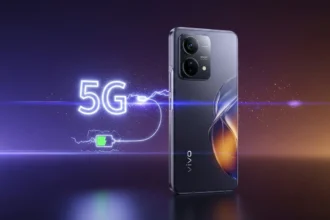Every September people who really like Apple prepare to experience shocks, as the new iPhone will be released at the annual event. What was the iPhone 16 last year? It could be said that iPhone 16 just came with small but stable improvements. The new iPhone 17 is finally out, and it’s packing a lot of cool stuff like brighter displays, better cameras, longer battery lives, and new AI-powered features because of iOS 26.
However, the most important question is still there: If you have the iPhone 16, is it really worth switching to the iPhone 17? Let’s analyze it by looking at the design, performance, cameras, battery, and price to find out whether this upgrade is a must-have or just a nice-to-have.
Design and Build Quality
Apple is not doing something totally new, but the iPhone 17 is somehow more refined than the previous one due to the small improvements. The smaller bezels give it a more stylish and up-to-date appearance. Besides, Apple has improved the Ceramic Shield glass, making it more resistant to drops—a nice change after last year’s scratching complaints.
The device has also lost some weight, and it is therefore more comfortable to use with just one hand despite the slightly bigger display. The colors were updated with new pastels and a deep blue that is already a favorite among customers.
The iPhone 16 still retains its premium allure, but it is undeniable that the iPhone 17 is more elegant in the hand.
Display Comparison
The screen is the one thing where the difference will be obvious to you immediately. The iPhone 17 boasts a 6.3-inch OLED display with a ProMotion 120 Hz refresh rate, an always-on display, and an unbelievable 3,000 nits peak brightness.
Next to each other, the iPhone 16’s 6.1-inch OLED limited at 60 Hz and ~1,600 nits brightness looks old-fashioned. Using the iPhone 17 for scrolling through apps, gaming, and even just surfing the internet is lighter and faster.
Moreover, HDR content viewing is noticeably better. The iPhone 17 is still quite clear even if you are watching it in the sun, while the iPhone 16 cannot be seen well in direct sunlight. So, if you are a visual person, movie, game, or photography, the iPhone 17 is a huge leap.
Performance and Software
Under the hood, Apple’s A19 Bionic chip powers the iPhone 17, while the iPhone 16 relies on the A18. Benchmarks show about a 15–20% bump in raw performance, but the real story is in AI-heavy tasks.
iOS 26 introduces a “Liquid Glass” design with smoother animations, but more importantly, it integrates AI across the system. From real-time transcription to smart photo editing and predictive text, these features shine brighter on the A19, which was built with AI acceleration in mind.
Another welcome change: the iPhone 17 now starts at 256GB storage, double the iPhone 16’s entry-level 128GB. Some Pro versions also come with 8 GB of RAM, which helps with multitasking.
For everyday use, both phones are fast. But if you want your device to feel future-proof for the next 4–5 years, the iPhone 17 is clearly better equipped.
Camera Upgrades
Apple continues to push the envelope with smartphone photography, and the iPhone 17 delivers some of the most noticeable changes.
- iPhone 16: 48MP wide + 12MP ultra-wide, 12MP front camera.
- iPhone 17: Dual 48MP rear lenses with improved sensors, and a front camera upgraded to 18MP (some reports even suggest 24MP) with OIS.
What is the practical application of this? More detailed low-light photos, better selfies, and fluid videos. With the iPhone 17, you get dual capture, meaning the recording of the front as well as the back cameras can be done simultaneously. So developers get an additional new tool to work with. Ultra stabilization, too, makes the video much smoother when handheld, thus saving the trouble of carrying an external gimbal.
Side-by-side comparisons reveal that iPhone 17 is capable of making pictures brighter and more detailed with minimal noise, particularly in challenging lighting situations.
Battery Life and Charging
Apple claims the iPhone 17 delivers the longest battery life ever on an iPhone, and early tests seem to back that up.
- iPhone 16: ~3561 mAh, up to 22 hours of video playback.
- iPhone 17: ~3692–4190 mAh (depending on model), up to 30 hours of video playback.
In real-world use, that means an extra 4–6 hours of screen time compared to the iPhone 16. For power users who are constantly on the go, that’s a big deal.
Charging speeds have also improved slightly, with MagSafe supporting around 25W versus 20W on the iPhone 16. It’s not groundbreaking, but every little bit helps.
Price and Storage Options
Pricing always stirs debate. The iPhone 17 is more expensive at launch, but Apple doubled the base storage to 256GB. The iPhone 16’s 128GB model feels cramped in 2025, especially with 4K video files and larger apps.
If you’ve been juggling iCloud storage, the iPhone 17 offers more breathing room without forcing you into cloud dependency. That makes it a better long-term value, even if the initial price stings.
Other Key Features
USB-C is the common interface for the two phones, but the iPhone 17 Pro editions are capable of faster data transfers (which is very convenient for videographers). Besides that, Apple has also updated the microphones and speakers in order to have better call and recording quality.
Undoubtedly, the camera shortcut button gets the most praise from the users, as taking a quick snapshot is now a simple task—they don’t have to go through the menus anymore. Moreover, the iPhone 17 with AI-enabled editing features feels like a friendly tool for the creators.
Side-by-Side Comparison Table
| Feature | iPhone 16 (2024) | iPhone 17 (2025) |
|---|---|---|
| Display | 6.1″ OLED, 60Hz, ~1,600 nits | 6.3″ OLED, 120Hz ProMotion, Always-On, 3,000 nits |
| Chipset | A18 Bionic | A19 Bionic |
| RAM / Storage | 6GB RAM, starts at 128GB | 8GB RAM (Pro), starts at 256GB |
| Rear Cameras | 48MP wide + 12MP ultra-wide | Dual 48MP lenses, improved sensors |
| Front Camera | 12MP, no OIS | 18–24MP, OIS support |
| Battery | ~3561 mAh, up to 22 hrs video | ~3692–4190 mAh, up to 30 hrs video |
| Charging | MagSafe, ~20W | Faster MagSafe, ~25W |
| Design | Ceramic Shield, slightly thicker bezels | Slimmer bezels, stronger Ceramic Shield, lighter build |
| Colors | Standard palette | New pastel shades + deep blue |
| Software | iOS 26, Liquid Glass UI | iOS 26 + exclusive AI tools & camera shortcut button |
| Connectivity | USB-C, Wi-Fi 6E | USB-C (faster transfer on Pro), Wi-Fi 7 |
| Price (Base) | Lower, but only 128GB | Higher, but starts at 256GB |
Common User Problems and Criticisms
It is only fair to say that iPhone releases are never free from disputes. Some users who got hold of the iPhone 17 first have reported that the phone can be scratched easily even though Apple stated that the glass should be tougher. As a result, a few online users have called the issue “Scratchgate.” Connectivity, however, has been good all the time. Besides that, the majority of the present problems appear to be minor software bugs that the company will solve in upcoming updates.
The situation is opposite with the iPhone 16, which, in a year, has gradually gotten rid of its problems and leaves the 16 model as a good alternative if the user cares about stability.
Who Should Upgrade?
Here’s a quick guide:
- Upgrade if you’re a content creator or gamer:The brighter 120 Hz display, AI editing tools, and better cameras are worth it.
- Upgrade if you need more storage and battery: 256GB base and 30-hour video playback make life easier.
- Stick with iPhone 16 if you’re casual:For browsing, messaging, and streaming, the iPhone 16 is still excellent.
- Stick if budget matters most: Discounts on the iPhone 16 in 2025 make it a great deal.
Should You Upgrade in 2025?
With the iPhone 17, you get real and tangible improvements such as a more vibrant and smoother screen, a sturdier battery life, better cameras, and AI features to anticipate the future. In fact, it does not shake up the industry but still manages to resemble an almost perfect iPhone 16.
Now, if you are working with an ancient iPhone such as the 13 or 14, then there is no doubt that the iPhone 17 would be a fantastic upgrade. However, if you are the owner of an iPhone 16 and are not that desperate to have the new features, it is probably wise to keep your phone for one more year.
In the long run, the question as to whether the upgrader is considered “worth it” is less about Apple promotions and more about the user of the device. The iPhone 17 is a big leap forward for heavy users. However, for light users, the iPhone 16 is still a worthy competitor in 2025.












